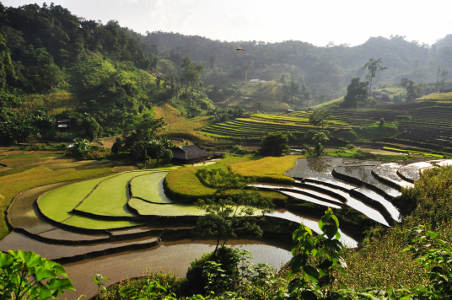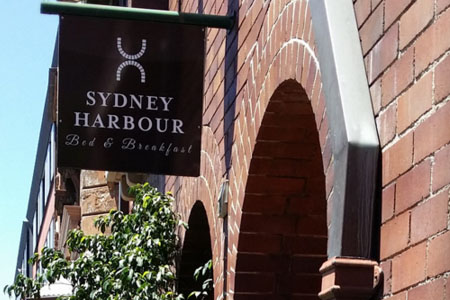

 The National Park covers 100.48km and it was founded in 1992 in an effort to protect the ecosystems and biodiversity of the area. Since then, an information centre and ecological research station have been established in the area amongst other additions. The park sits 145m above sea level, and unusually the karst lake is full year round. As the park is in the North of Vietnam, it experiences four seasons with temperatures just below zero in the coldest months to the mid thirties in the hottest months. The area has long been inhabited by small ethnic minority communities and was also occupied by a number of permanent French residents during the French colonial era.
The National Park covers 100.48km and it was founded in 1992 in an effort to protect the ecosystems and biodiversity of the area. Since then, an information centre and ecological research station have been established in the area amongst other additions. The park sits 145m above sea level, and unusually the karst lake is full year round. As the park is in the North of Vietnam, it experiences four seasons with temperatures just below zero in the coldest months to the mid thirties in the hottest months. The area has long been inhabited by small ethnic minority communities and was also occupied by a number of permanent French residents during the French colonial era.
BA BE – UNSPOILT HOME OF ETHNIC MINORITIES
Whilst Ba Be instrumental, Ba Be lake travel guidethere are other locations in Vietnam such as Sapa and Ha Giang where visitors may easily meet local ethnic minorities, these have become very tourist orientated. Ba Be is home to a great diversity of ethnic people including three main groups of Hmong, Dao and Tay. They do not live in a central town but live in hamlets scattered through the valleys, still living by fishing and farming. Ba Be lake shore is where the ethnic minority people gather to trade, selling their farming products such as fish, rice, corn and fruit in addition to some local handicrafts.
Spending time boating on the lake, visiting ethnic minority villages, observing their daily activities and living in a homestay will enable visitors to understand more about their culture, and taking the opportunity to help with farming or making handicrafts would enhance their appreciation. A local guide will show you around the lake, the jungle, the villages, telling wonderful stories about their culture and traditions, and may even invite you to join their family activities.
BA BE – IDEAL FOR TREKKING
Ba Be is considered by both native Vietnamese and visitorsTrekking in Ba Be national park, Ba Be travel guide to be one of the best trekking areas in the country. The whole district is dominated by the Pia Booc mountain range rising to a height of 1527m. It is the combination of the scenery, from the karst outcrops clad in rich vegetation to the paddy fields carpeting the lower slopes of the Na Nghe mountains; the rich variety of flora and fauna; and the rich cultural diversity which together make this a unique and rewarding location. Local guides are a wealth of invaluable knowledge; as well as keeping you safe, they know the which routes to take for the best sightseeing and wildlife spotting.
BA BE – IDEAL FOR LAKE KAYAKING
Kayaking is the best way to explore the breathtaking beauty of Ba Be Lake. Paddle through the islets; discover hidden caves; visit fishing villages. You can get closer to the limestone karsts, and find some secret corners of Ba Be lake and the Nang river.kayaking on Ba Be lake, Ba Be travel gudie
An added benefit of kayaking is that they can get you up close to karsts and into the caves that aren’t suitable for bigger boats. The lack of engine also makes this an eco way to travel without causing air or noise pollution.
When kayaking, suitable clothing is a must; it is essential to wear a life jacket, and we recommend wearing a t-shirt and shorts or a swimming suit in summer, warmer clothes in winter, wet shoes, hat, sun cream and sunglasses. A dry bag is extremely useful for storing your camera, insect repellent, water.
Kayaking tour is provided by the Ba Be Tourism Center or Mr Linh’s Homestay in Coc Toc Village.
BA BE – IDEAL FOR BIKING
Ba Be is great for exploring by bicycle. Sports bikes can be rented for around Cycling in Ba Be national park, Ba Be travel guide$10 per day. The main roads around the national park are mostly in good condition and don’t see much traffic. One day cycling around the park should enable you to visit Hua Ma Cave, Thac Bac Waterfall and some villages.
Car hire and motorbike taxis can also be arranged in Ba Be. Motorbike taxis (xe om) can be a good way to explore the park as the drivers usually know the best spots. Be sure to clearly agree your plans and price in advance.
BA BE – IDEAL FOR CAVING
Riddled with hundreds of cave systems – many of extraordinary scale and length – and spectacular underground rivers that discovered. However, Mr Linh has had a Very Big Adventure and has discovered a huge cave in the Hoang Tri Commune, in Ba Be District in the north of Vietnam. Although there are several huge caves in Central Vietnam, this is a major discovery in the north and another great reason to visit Ba Be National Park, which is a area of limestone karsts. Any visitors will feel that they are true explorers as nothing in the cave has yet been documented by geologists. The cave is 3-5 km in length and rises to a height of 40 metres. The water course comes from two different sources which meet at a junction. One stream is about 1.5 km and the other 2-4 km. Further exploration is needed to establish this. There are the most incredible rock formations, many stalagmites and stalactites, and huge stone columns, with unbelievable shapes and colours. There are bats, and other insects and also plants, so plenty to interest the naturalist. The entrance to the cave is in the middle of the mountains and well concealed by the jungle, so was very difficult to discover. So, be sure a new aventure trip in Ba Be.
IDEAL FOR TASTING LOCAL FOOD
Ba Be’s food specialities are anotIDEAL FOR TASTING LOCAL FOODher reason to relish your stay in the area. There are too many to mention but boiled chayote cooked with sesame or lon cap nach (literally pig carried under the arm) which are home pigs raised in the field or forest. Barbequed meat and fish and a huge variety of vegetables, together with dumplings, bamboo tube rice, noodles and eggs may all be part of the feast you can enjoy at the table of your host.
Ba Be Lake is definitely a place to remember, well worth the effort of the journey. It is breathtakingly beautiful, serene, culturally fascinating, whilst also offering a range of adventure activities. We look forward to seeing you here and sharing our little piece of heaven.


Holiday Accommodation































